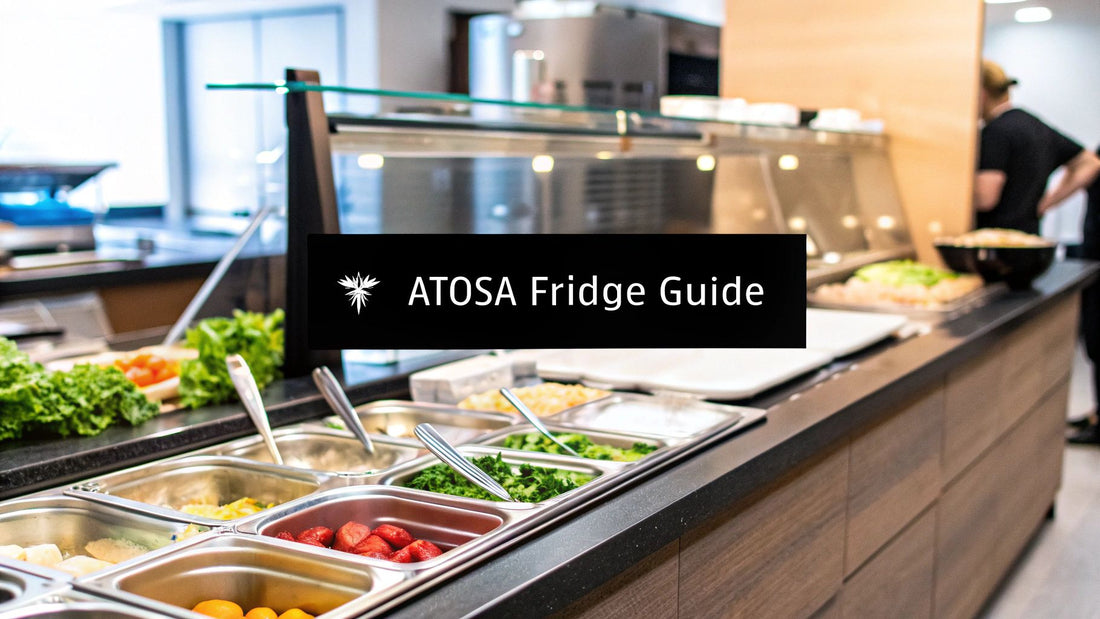
The Atosa 2 Door Refrigerator: An Essential Guide for Modern Chefs
Share
In the fast-paced, high-pressure environment of a commercial kitchen, the last thing a chef needs is equipment failure. When a refrigerator gives up, it’s not just an inconvenience—it's a full-blown crisis that can halt service and cost thousands. This is precisely why so many seasoned chefs and restaurant owners put their trust in the Atosa 2 door refrigerator. It’s the kind of reliable, heavy-duty workhorse you need to keep your kitchen running at peak performance, day in and day out.
Why Top Kitchens Rely on Atosa Refrigerators
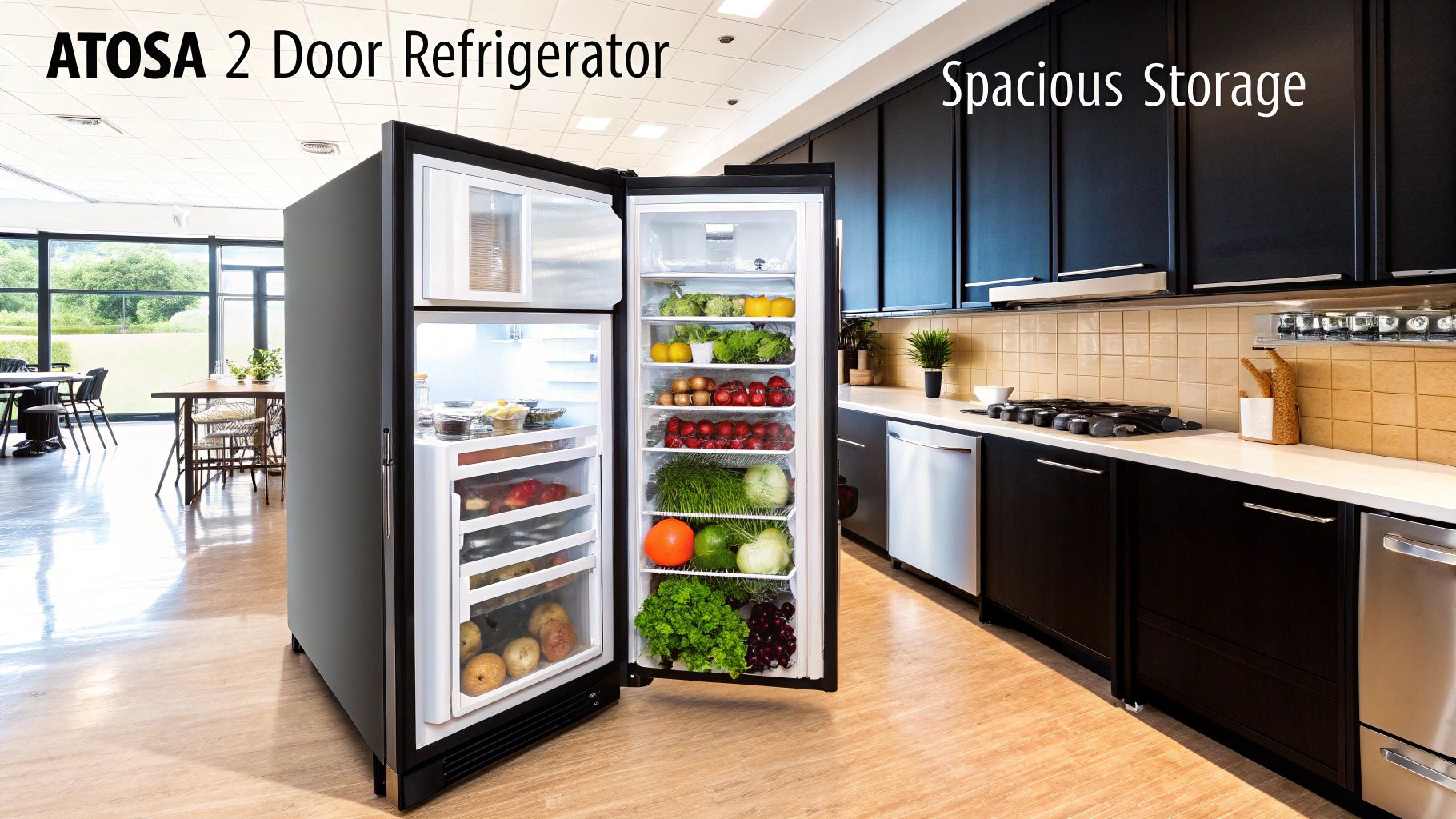
Think of the Atosa 2 door refrigerator as the silent, dependable backbone of your kitchen. It’s not flashy, but it expertly combines rugged construction with the kind of efficient, precise cooling that protects your inventory and your profits. In an industry where margins are tight and the pace is relentless, investing in refrigeration you can count on isn't just a smart move; it's an essential business strategy.
This isn't just a hunch, either. The entire industry is trending toward more robust and efficient cooling solutions.
The global market for commercial refrigerators was valued at around $66.3 billion in 2021 and is on track to hit an estimated $85.6 billion by 2025. This massive growth underscores a key industry trend: high-performance refrigeration has become critical for high-volume businesses like restaurants and hotels.
This trend makes one thing clear: picking the right refrigerator is more vital to your success than ever before.
The Foundation of a Reliable Kitchen
A dependable refrigerator is the bedrock of any successful food operation. It's your first and best defense against food spoilage, a problem that eats directly into your food costs and overall profitability. A unit like the Atosa 2 door refrigerator is specifically engineered to handle the relentless stress of a commercial kitchen—from doors swinging open a hundred times during a dinner rush to the high ambient heat of the cookline.
But its job is about more than just keeping things cold. A trustworthy refrigerator is key to:
- Food Safety: Maintaining consistent, food-safe temperatures is absolutely critical. It’s how you ace health inspections and, more importantly, keep your customers safe and build your reputation.
- Inventory Protection: This single piece of equipment is responsible for guarding thousands of dollars worth of ingredients. A breakdown means that money goes straight into the trash.
- Operational Efficiency: A well-designed unit with easy-to-access, organized shelving helps your kitchen staff move faster and more efficiently, which is a huge advantage during peak hours.
Choosing your refrigeration is a serious business decision. For a closer look at what makes this brand stand out, check out our complete guide on the Atosa refrigerator. When you invest in a trusted name like Atosa, you're not just buying an appliance. You're buying peace of mind and building a stronger, more resilient business from the ground up.
A Look Under The Hood: The Smart Features of Your Atosa Refrigerator
A spec sheet can give you the numbers, but it doesn't tell the whole story. To really get why the Atosa 2 door refrigerator is such a workhorse in so many professional kitchens, you have to look at how its features solve the day-to-day problems chefs and owners face. This isn't just a cold box; it’s a piece of equipment where every single component was chosen with a purpose.
You can feel the quality right out of the crate. The heavy-duty stainless steel build isn't just for show—it's like armor for the chaos of a professional kitchen. It’s made to shrug off the dents, dings, and spills, staying hygienic and reliable for years. That tough exterior is protecting some seriously smart technology on the inside.
The Heart of Reliable Cooling
At the core of any good refrigerator is its compressor, and Atosa doesn't cut corners here. This is the engine that drives the whole system, pumping cold air consistently to keep your inventory safe. Atosa uses top-tier European compressors from brands like Embraco, which is a name industry pros trust for sheer durability and performance. This commitment means the unit holds its temperature, even when your line cooks are opening and closing the doors a hundred times during a dinner rush.
But a powerful compressor needs precision guidance.
That’s where the Dixell digital temperature controller comes in. It gives you surgical control over the internal environment. This isn't some vague "colder/warmer" dial; it lets you lock in a precise temperature, usually between 33°F and 38°F, and know it’s staying there.
This kind of accuracy is non-negotiable for passing health inspections, preventing spoilage, and serving food you can be proud of.
Designed for a Smarter Workflow
Beyond the cooling tech, it's the little things in the Atosa's design that really make a difference in your daily grind. You can tell they’ve spent time in a real kitchen.
- Self-Closing Doors: We’ve all seen it—a door left slightly ajar, wasting energy and putting food in the danger zone. Atosa’s doors swing shut automatically, which saves your compressor and your peace of mind.
- Stay-Open Feature: When you're loading a big delivery, the last thing you need is a door swinging into you. Push these doors past 90 degrees, and they stay put, freeing up both hands to stock shelves quickly and safely.
- Epoxy-Coated Shelving: The inside of a fridge is a damp place. These epoxy-coated shelves are built to resist the rust and corrosion that can plague lesser units, keeping things clean and durable for the long haul.
Choosing an energy-efficient unit like the Atosa also has a direct impact on your expenses. This isn't just a hypothetical benefit; the savings are real.
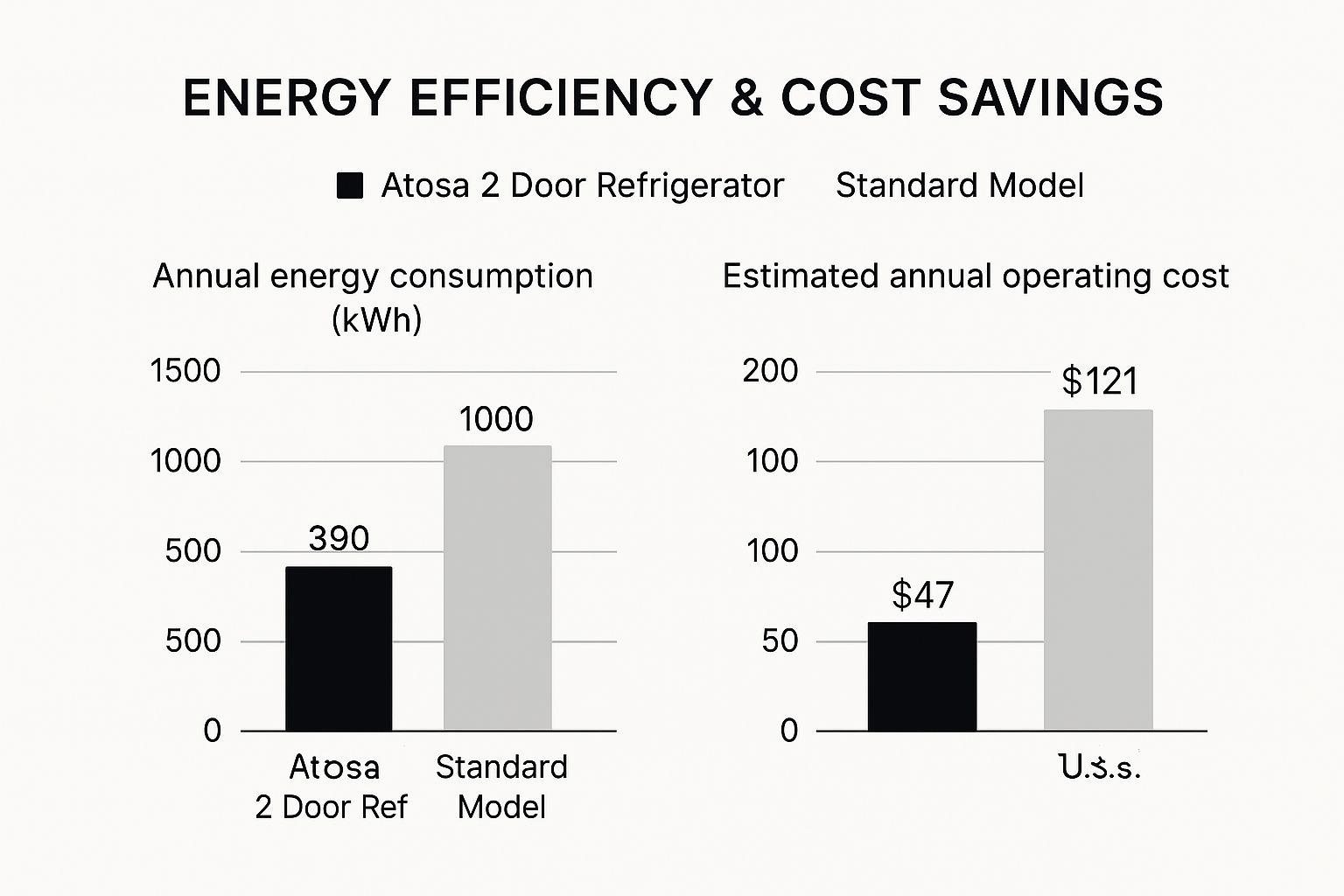
As you can see, lower energy use adds up to significant savings on your utility bills over the year. When you add it all up—from the tough build to the smart doors—every feature works together to make your kitchen run smoother, keep your food safe, and protect your bottom line.
How Atosa's Energy Efficiency Boosts Your Bottom Line
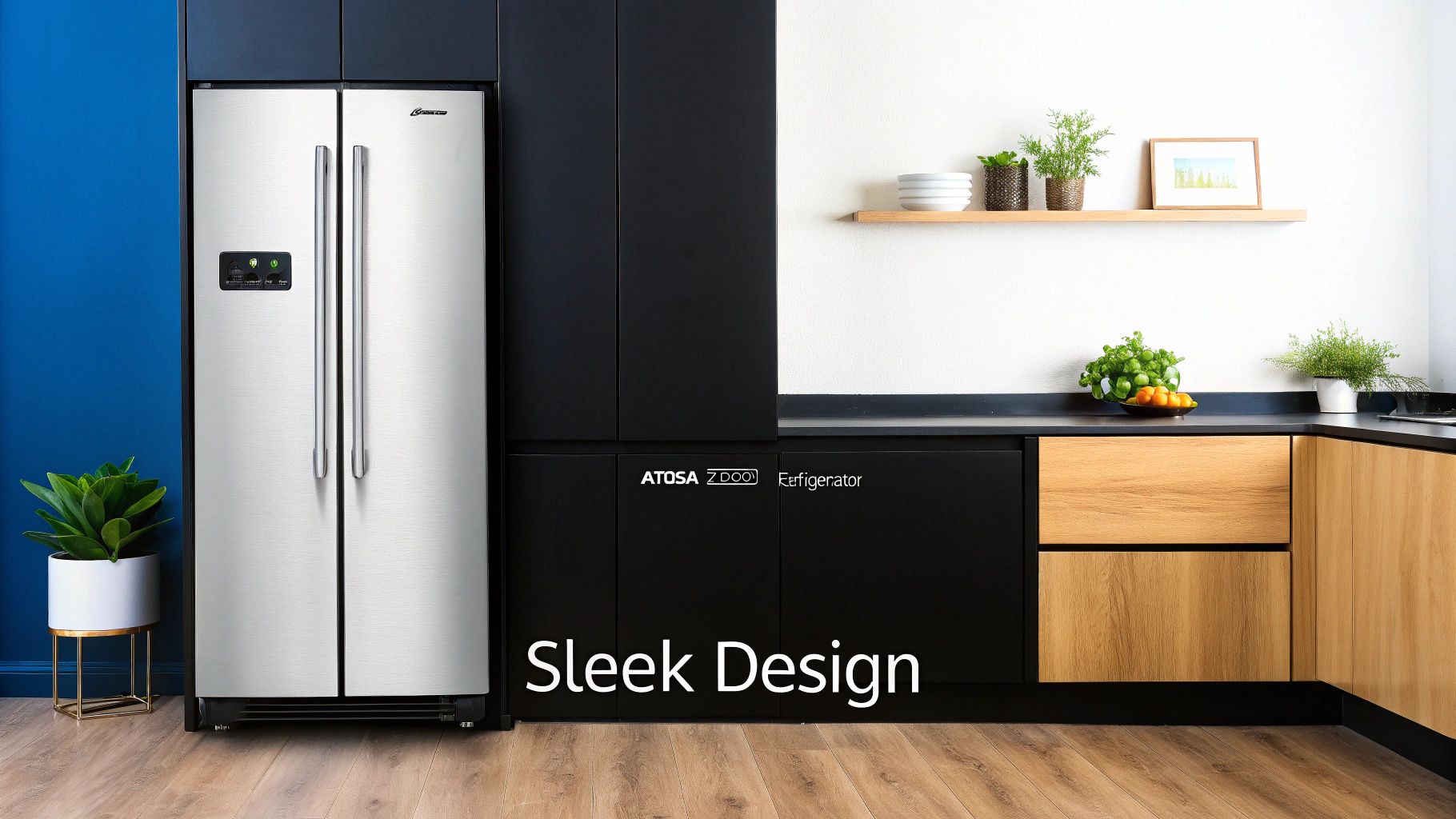
If you run a commercial kitchen, you know that keeping an eye on operational costs is a constant battle. While things like rent and labor are pretty much set in stone, your utility bill is one area where a smart equipment choice can really make a difference. This is exactly where the Atosa 2 door refrigerator shines, turning an essential piece of equipment into a money-saver for your business.
Think about it—your refrigerator is one of the few things in your kitchen that runs 24/7. It never gets a day off. Choosing a unit that sips electricity instead of chugging it is like getting a small but steady discount on your operating costs, month after month. This isn't just a nice little perk; it’s a strategic move that pays for itself over the long haul.
Unpacking the ENERGY STAR Advantage
You'll often see the ENERGY STAR logo on Atosa refrigerators, and as a savvy owner, it's important to know what that actually means for your kitchen. It's much more than just marketing flair. It’s a seal of approval backed by strict government testing that guarantees superior efficiency.
An ENERGY STAR certified refrigerator is engineered from the inside out to save power. These models are built with advanced components that work together to keep everything perfectly chilled while using significantly less electricity. It's a clear sign that you're getting a high-performance machine.
An Atosa 2 door refrigerator's energy efficiency is a major win. Models that earn the ENERGY STAR label—which many Atosa units do—are proven to be at least 10-15% more efficient than standard, non-certified refrigerators. That standard, set by the U.S. Environmental Protection Agency, directly translates into real, ongoing savings on your utility bills. You can explore more about Atosa's efficiency benchmarks on therestaurantwarehouse.com.
How Smart Design Translates to Savings
The savings you get from an Atosa unit aren't from a single magic bullet. Instead, they come from a whole system of smart design choices working together.
- High-Efficiency Compressors: Atosa equips its refrigerators with top-of-the-line compressors. They provide powerful, consistent cooling but draw less energy to do it. Think of it as the unit's reliable heart, built for both endurance and efficiency.
- Eco-Friendly Refrigerant: Using modern refrigerants like R290 hydrocarbon is a double win. It's much better for the environment and also happens to be more effective at heat transfer. This means the cooling system doesn't have to work as hard, saving energy.
- Superior Insulation: The walls and doors are packed with high-density, polyurethane insulation. This creates a solid thermal barrier that locks the cold air in and keeps the warm kitchen air out, reducing the workload on the compressor.
At the end of the day, choosing an energy-efficient Atosa 2 door refrigerator is just a smart financial decision. It directly lowers your monthly overhead, freeing up cash you can put back into growing your business—whether that's developing a new menu item or running a marketing campaign. It’s a choice that’s good for your bottom line and aligns with the industry's push for sustainability.
Proper Placement and Installation for Peak Performance
So, your new Atosa 2-door refrigerator has arrived. Unboxing it is exciting, but what you do next is what really counts. Where and how you install this unit will directly affect its performance, how much energy it uses, and ultimately, how long it lasts. Getting the placement right from the start is the single best thing you can do to protect your investment.
Think of your refrigerator's compressor like its engine—it generates a lot of heat and needs fresh air to cool down. One of the biggest mistakes we see in commercial kitchens is cramming a refrigerator into a tight space. When hot air gets trapped, the compressor has to work much, much harder to keep things cool. That leads to higher energy bills, stress on the components, and a much shorter lifespan for your unit.
Setting the Stage for Success
Before you even think about plugging it in, let's nail down two critical steps: finding the perfect spot and making sure the unit is perfectly level. These might seem like minor details, but they are absolutely essential for the long-term health of your refrigerator.
- Give It Room to Breathe: You absolutely must leave at least 3-4 inches of clearance around the back and sides. This isn't a suggestion; it's a requirement for proper airflow. That space lets the heat from the compressor and condenser coils escape, which is key to efficient operation.
- Find a Level Footing: Grab a level and make sure the refrigerator is standing perfectly flat. If it's tilted, even slightly, the doors won't seal properly. A bad seal means cold air is constantly leaking out, forcing the compressor to run nonstop just to keep up. That's a quick way to burn out the motor and run up your electricity bill.
A few extra minutes spent on these setup tasks will pay you back tenfold by ensuring your Atosa runs smoothly from day one.
A proper installation isn't just about following the manual; it's a fundamental part of a well-organized kitchen setup. Protecting your equipment investment starts with a solid plan for placement and setup, which is a key component of any comprehensive commercial kitchen equipment checklist. For more insights on setting up your entire kitchen for success, our guide on the commercial kitchen equipment checklist can be a valuable resource.
The Final Connection
With your refrigerator perfectly positioned and level, the last piece of the puzzle is the electrical hookup. This is not the time to take shortcuts.
Your Atosa 2-door refrigerator is a workhorse, and it needs its own dedicated electrical circuit. Never, ever plug it into a power strip or an outlet that’s already powering other heavy-duty appliances like a microwave or a stand mixer. That’s a surefire way to trip a breaker right in the middle of a dinner rush.
Double-check that the outlet matches the voltage requirements for your specific model. If you have any doubt about your kitchen's wiring or electrical capacity, please call a qualified electrician. It’s a small investment that prevents frustrating service calls, protects the refrigerator’s electronics, and ensures you get safe, reliable performance for years to come.
Simple Maintenance to Extend Your Refrigerator's Life
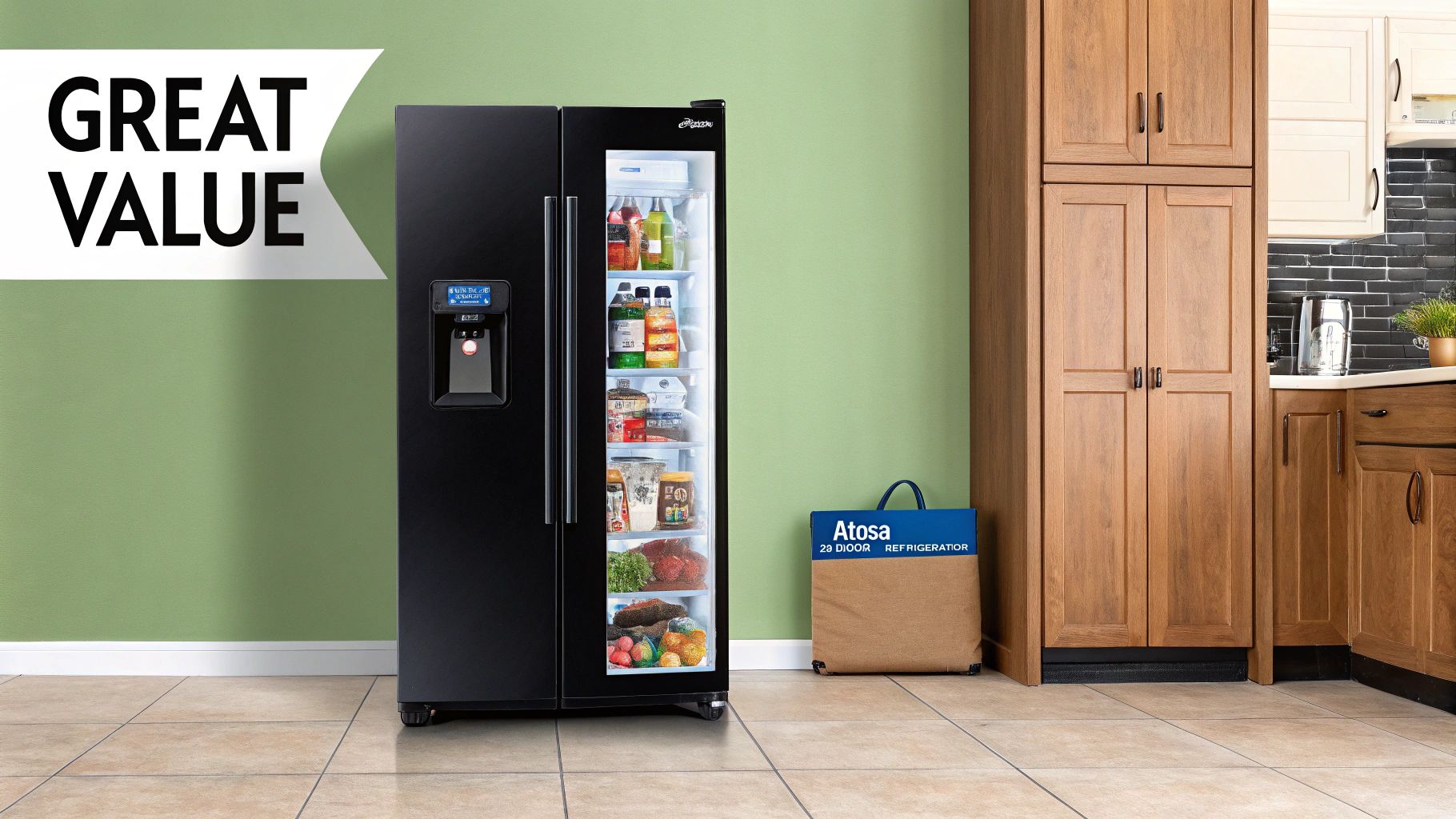
When you're running a busy kitchen, the last thing you need is a surprise equipment failure. A little proactive care for your Atosa 2 door refrigerator is always going to be cheaper and far less stressful than making frantic repair calls. Think of it this way: your fridge is a major investment, and a few minutes of routine maintenance can prevent the kind of breakdown that spoils thousands of dollars in inventory and grinds your service to a halt.
This isn't about adding another complicated chore to your team's list. It's about building small, consistent habits that protect your bottom line and keep your kitchen running smoothly. By breaking down the essentials into a simple schedule, you can easily work them into your existing cleaning routines.
Your Daily and Weekly Maintenance Routine
The best maintenance becomes second nature. These quick daily and weekly checks are your first line of defense, catching small issues before they snowball into major problems. They're all about ensuring food safety and operational consistency.
Daily Habits (Just 2-3 Minutes):
- Exterior Wipe-Down: Grab a soft cloth and a mild cleaner to wipe down the stainless steel exterior and door handles. This simple step keeps the unit looking professional and prevents grime from building up.
- Gasket Check: Take a quick look at the magnetic door gaskets. You're searching for any rips, cracks, or bits of food that could break the seal. A tight seal is absolutely critical for locking in the cold air.
Weekly Habits (5-10 Minutes):
- Interior Cleaning: Empty the shelves one section at a time and give all interior surfaces a thorough wipe-down with a food-safe sanitizer. This is key to preventing cross-contamination and keeping odors at bay.
- Drainage Check: Peek inside and make sure the interior drain line is clear. Any blockage here can cause water to pool inside the cabinet, creating a real mess.
Regular maintenance isn't just a suggestion; it's a non-negotiable part of running a professional kitchen. Skipping these simple tasks leads to poor performance, higher energy bills, and early equipment failure, turning your reliable workhorse into a costly headache.
The Most Important Monthly Task
If you only do one thing on a monthly basis, make it this: clean the condenser coils.
Think of these coils as the lungs of your refrigerator. They are responsible for releasing heat from the refrigeration system. When they get clogged with the dust, grease, and grime found in every commercial kitchen, your unit simply can't "breathe" properly. This forces the compressor to work much harder and longer than it was designed to, spiking your energy bills and putting a massive strain on the heart of your Atosa 2 door refrigerator.
Cleaning the coils every 30-90 days is the single most effective action you can take to extend the life of your unit. Just unplug the refrigerator, use a stiff brush to gently clear the fins, and then vacuum up all the loose debris. It's that simple.
This entire maintenance philosophy—from daily wipe-downs to monthly coil cleaning—applies across all refrigeration. The same principles that keep your refrigerator humming along also apply to its colder cousin, the freezer. For more specifics, check out our complete guide on Atosa freezer maintenance instructions. By dedicating just a few minutes, you ensure your equipment stays reliable for years to come.
Got Questions About Atosa Refrigerators? We've Got Answers.
When you're outfitting a kitchen, you need to be sure about every piece of equipment. Let's tackle some of the most common questions we hear from chefs and restaurant owners about the Atosa 2-door refrigerator, so you can feel confident in your choice.
What Kind of Warranty Does Atosa Offer?
Atosa backs their refrigerators with a pretty solid warranty. You'll typically get a multi-year warranty that covers both parts and labor for the entire unit.
The real standout, though, is the separate, extended warranty they offer just for the compressor. Think of the compressor as the heart of your refrigerator; having extra coverage on this critical component shows Atosa's confidence in their build quality and can save you a fortune in future repairs.
Always double-check the specific warranty terms with your dealer when you buy. It’s a huge part of what you're investing in.
How Often Should I Be Cleaning the Condenser Coils?
This is a big one for performance. Plan on cleaning the condenser coils on your Atosa unit at least every 90 days.
If your kitchen has a lot of grease in the air—say, you're running deep fryers all day—you'll want to bump that up to a monthly cleaning. Keeping those coils free of dust and grime is the single best thing you can do to prevent the compressor from overworking, guzzling electricity, and failing early.
Can I Put an Atosa Refrigerator Right Next to My Ovens?
While it might look like a great way to save space, putting your refrigerator next to the cookline is a bad idea. Any refrigerator exposed to the high heat from ranges or ovens has to fight a constant battle to stay cool.
This struggle leads to two big problems:
- Sky-high energy bills as the unit works overtime.
- Serious wear and tear on the compressor, which can dramatically shorten its lifespan.
For the sake of your equipment and your utility budget, make sure your Atosa 2-door refrigerator has plenty of breathing room, far away from any direct heat sources.
Ready to bring the reliability and efficiency of an Atosa to your kitchen? See the full lineup of commercial refrigeration at Encore Seattle Restaurant Equipment and find the perfect fit for your operation. We can also help you discover exclusive deals and stay informed on the latest industry trends.
